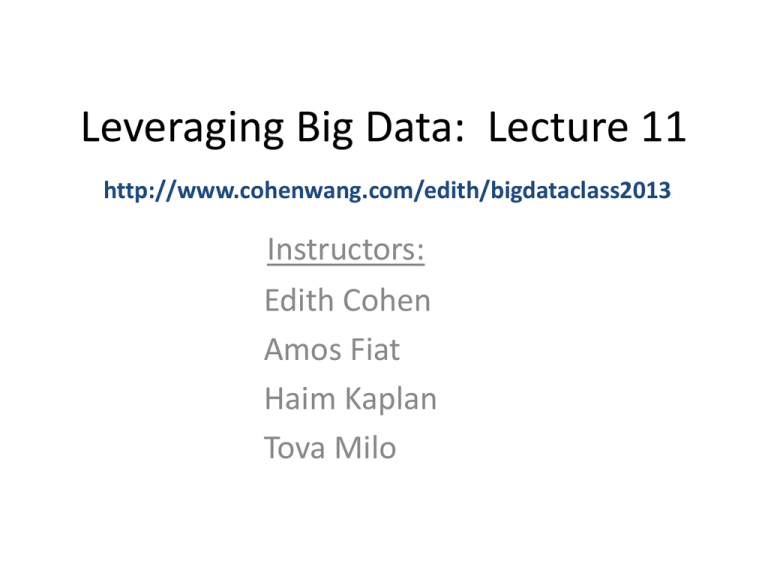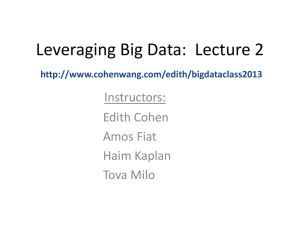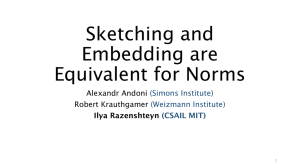Leveraging Big Data: Lecture 11 - Cohen
advertisement

Leveraging Big Data: Lecture 11
http://www.cohenwang.com/edith/bigdataclass2013
Instructors:
Edith Cohen
Amos Fiat
Haim Kaplan
Tova Milo
Today’s topics
Graph datasets
Mining graphs: which properties we look at
and why
Challenges with massive graphs
Some techniques/algorithms for very large
graphs:
Min-Hash sketches of reachability sets
All-Distances sketches
Graph Datasets:
Represent relations between “things”
Bowtie structure of the Web Broder et. al. 2001
Dolphin interactions
Graph Datasets
Hyperlinks (the Web)
Social graphs (Facebook, Twitter, LinkedIn,…)
Email logs, phone call logs , messages
Commerce transactions (Amazon purchases)
Road networks
Communication networks
Protein interactions
…
Properties
Directed/Undirected
Snapshot or with time dimension (dynamic)
One or more types of entities (people,
pages, products)
Meta data associated with nodes
Some graphs are really large: billions of
edges for Facebook and Twitter graphs
Mining the link structure:
Node/Network-level properties
Connected/Strongly connected components
Diameter (longest shortest s-t path)
Effective diameter (90% percentile of pairwise
distance)
Distance distribution (number of pairs within
each distance)
Degree distribution
Clustering coefficient: Ratio of the number of
closed triangles to open triangles.
Diameter
Diameter is 3
Distance distribution of
Distance 1: 5
Distance 2: 5
Distance 3: 1
Triangles
Open triangle
Triangles
closed triangle
Triangles
Social graphs have many more
closed triangle than random graphs
“Communities” have more closed
triangles
…Mining the link structure
• Centrality (who are the most important
nodes?)
• Similarity of nodes (link prediction, targeted
ads, friend/product recommendations, MetaData completion)
• Communities: set of nodes that are more
tightly related to each other than to others
• “cover:” set of nodes with good coverage
(facility location, influence maximization)
Communities Example (overlapping)
Star Wars
Communities Example (overlapping)
Ninjago
Communities Example (overlapping)
Bad Guys
Communities Example (overlapping)
Good Guys
Also a good “cover”
Centrality
Central Guys
Centrality
Which are the most important nodes ?
… answer depends on what we want to capture:
Degree (in/out): largest number of followers,
friends. Easy to compute locally. Spammable.
Eigenvalue (PageRank): Your importance/
reputation recursively depend on that of your
friends
Betweenness: Your value as a “hub” -- being
on a shortest path between many pairs.
Closeness: Centrally located, able to quickly
reach/infect many nodes.
Centrality
Central with respect
to all measures
Computing on Very Large Graphs
Many applications, platforms, algorithms
Clusters (Map Reduce, Hadoop) when applicable
iGraph/Pregel better with edge traversals
(Semi-)streaming : pass(es), keep small info (per-node)
General algorithm design principles :
settle for approximations
keep total computation/ communication/
storage “linear” in the size of the data
Parallelize (minimize chains of dependencies)
Localize dependencies
Next: Node sketches
(this lecture and the next one)
Min-Hash sketches of reachability sets
All-distances sketches (ADS)
Connectivity sketches (Guha/McGregor)
Sketching:
Compute a sketch for each node, efficiently
From sketch(es) can estimate properties that
are “harder” to compute exactly
Review (lecture 2): Min Hash Sketches
“Items” 𝑽
Random hash function 𝒉: 𝑽 → [𝟎, 𝟏]
For a subset 𝑵 ⊂ 𝑽 we get a sketch 𝒔(𝑵)
From 𝒔(𝑵) we can:
Estimate cardinality |𝑵|,
Obtain a random sample of 𝑵,
Estimate similarity, union, sketch merged sets
Basic sketch (𝒌 = 𝟏) : maintain the minimum 𝒉(𝑵)
Review: Min-Hash Sketches
𝑘 values 𝒚𝟏 , 𝒚𝟐 , … , 𝒚𝒌 from the range of the hash function
(distribution).
k-mins sketch: Use 𝑘 “independent” hash functions: ℎ1 , ℎ2 , … , ℎ𝑘
Track the respective minimum 𝑦1 , 𝑦2 , … , 𝑦𝑘 for each function.
Bottom-k sketch: Use a single hash function: ℎ
Track the 𝑘 smallest values 𝑦1 , 𝑦2 , … , 𝑦𝑘
k-partition sketch: Use a single hash function: ℎ′
Use the first log 2 𝑘 bits of ℎ′(𝑥) to map 𝑥 uniformly to one of 𝑘
parts. Call the remaining bits ℎ(x).
For 𝑖 = 1, … , 𝑘 : Track the minimum hash value 𝑦𝑖 of the elements
in part 𝑖.
All sketches are the same for 𝑘 = 1
Sketching Reachability Sets
Reachability Set of
Size 4
Reachability Set of
Size 13
Why sketch reachability sets ?
From reachability sketch(es) we can:
Estimate cardinality of reachability set
Get a sample of the reachable nodes
Estimate relations between reachability sets
(e.g., Jaccard similarity)
Exact computation is costly: 𝑂(𝑚𝑛) with 𝑛
nodes and 𝑚 edges, representation size is
massive: does not scale to large networks!
Min-Hash sketches of all
Reachability sets
0.37
0.12
0.45
0.28
0.34
0.23
0.85
0.06
0.95
0.93
0.77
0.69
0.32 hash values 𝐡(𝒗) ∼ 𝑼[𝟎, 𝟏]
Min-Hash sketches of all
Reachability Sets: 𝑘 = 1
For each 𝑣: 𝐬 𝒗 ← 𝐦𝐢𝐧 𝒉(𝒖)
𝒗↝𝒖
Depending on application, may also want
to include node ID in sketch:
𝐚𝐫𝐠𝐦𝐢𝐧 𝒉(𝒖)
𝒗↝𝒖
Min-Hash sketches of all
Reachability Sets: 𝑘 = 1
0.37 {0.23}
0.45
{0.23}
{0.23}
0.23
{0.23}
0.85
{0.06}
0.06
{0.06}
0.69
{0.06} {0.06}
0.32
0.95
0.12 {0.12} 0.28
{0.12}
0.34
{0.12}
{0.12}
0.93
{0.12}
0.77
𝐬 𝒗 ← 𝐦𝐢𝐧 𝒉(𝒖)
𝒗↝𝒖
Min-Hash sketches of all Reachability
Sets: bottom-2 (𝑘 = 2)
For each 𝑣: 𝐬 𝒗 ← 𝐛𝐨𝐭𝐭𝐨𝐦−𝟐 𝒉(𝒖)
𝒗↝𝒖
Min-Hash sketches of all
Reachability Sets: bottom-2
0.37
0.12
0.45
{0.23,0.37}
0.23
0.34
0.28
{0.12,0.23}
0.85
0.93
0.06 {0.06,0.12}
0.95
0.32
0.77
0.69
Next: Computing Min-Hash sketches of
all reachability sets efficiently
Sketch size for a node: 𝑂(𝑘)
Total computation ≈ 𝑂(𝑘𝑚)
Algorithms/methods:
Graphs searches (say BFS)
Dynamic programming/ Distributed
Computing Min-Hash Sketches of all
Reachability Sets: 𝑘 = 1 BFS method
𝐬 𝒗 ← 𝐦𝐢𝐧 𝒉(𝒖)
𝒗↝𝒖
Iterate over nodes 𝑢 by increasing ℎ(𝑢):
Visit nodes 𝑣 through a reverse search from 𝑢:
IF s 𝑣 = ∅,
𝑠 𝑣 ← ℎ(𝑢)
Continue search on inNeighbors(𝑣)
ELSE, truncate search at 𝑣
Compute Min-Hash sketches of all
Reachability Sets: 𝑘 = 1, BFS
0.37 {0.23}
0.45
{0.23}
{0.23}
0.23
{0.23}
0.85
{0.06}
0.06
{0.06}
0.69
{0.06} {0.06}
0.32
0.95
0.12 {0.12} 0.28
{0.12}
0.34
{0.12}
{0.12}
0.93
{0.12}
0.77
𝐬 𝒗 ← 𝐦𝐢𝐧 𝒉(𝒖)
𝒗↝𝒖
Computing Min-Hash sketches of all
reachability sets: 𝑘 = 1 BFS method
Analysis:
Each arc is used exactly once 𝑂(𝑚)
Parallelizing BFS-based Min-Hash
computation
Each graph search depends on all previous
ones: seems like we need to perform 𝑛
searches sequentially.
How can we reduce dependencies ?
Parallelizing BFS-based Min-Hash
computation
Idea (𝑘 = 1):
Create a super-node of the 𝑛/2 lowest hash
nodes.
Perform a (reverse) search from super-node and
mark all nodes that are accessed.
Concurrently perform searches:
From the lowest-hash 𝑛/2 nodes (sequentially)
From the highest-hash 𝑛/2 (sequentially).
Prune searches also at marked nodes
Parallelizing BFS-based Min-Hash
computation
Correctness:
For the lower 𝒏/𝟐 hash values: computation is
the same.
For the higher 𝒏/𝟐:
We do not know the minimum reachable hash
from higher-hash nodes, but we do know it is
one of the lower 𝑛/2 hash values. This is all we
need to know for correct pruning.
Parallelizing BFS-based Min-Hash
computation
This only gives us 𝒏/𝟐 instead of 𝒏
sequential searches.
How can we obtain more parallelism ?
We recursively apply this to each of the
lower/higher sets:
Parallelizing BFS-based Min-Hash
computation
Nodes ordered by ℎ(𝑢)
Super-nodes created in recursion
The depth of dependencies is at most log 2 𝑛
The total number of edge traversals can
increase by a factor of log 2 𝑛
Computing Min-Hash Sketches of all
Reachability Sets: bottom-𝑘, BFS method
Next: Computing sketches using the BFS method
for k>1
𝐬 𝒗 ← 𝐛𝐨𝐭𝐭𝐨𝐦−𝒌 𝒉(𝒖)
𝒗↝𝒖
Computing Min-Hash Sketches of all
Reachability Sets: bottom-𝑘, BFS method
𝐬 𝒗 ← 𝐛𝐨𝐭𝐭𝐨𝐦−𝒌 𝒉(𝒖)
𝒗↝𝒖
Iterate over nodes 𝑢 by increasing ℎ(𝑢):
Visit nodes 𝑣 through a reverse search from 𝑢:
IF s 𝑣 < 𝑘,
𝑠 𝑣 ← 𝑠 𝑣 ∪ {ℎ 𝑢 }
Continue search on inNeighbors(𝑣)
ELSE, truncate search at 𝑣
Min-Hash sketches of all
Reachability Sets: bottom-2
0.37
0.12
0.45
{0.23, 0.37 }
0.23
0.34
0.28
{0.12, 0.23 }
0.85
0.06
0.93
{0.06, 0.12 }
0.95
0.77
0.69
0.32
Computing Min-Hash Sketches of all Reachability
Sets: 𝑘 = 1 Distributed (DP)
Next: back to 𝑘 = 1.
We present another method to compute the
sketches. The algorithm has fewer dependencies.
It is specified for each node. It is suitable for
computation that is:
Distributed, Asynchronous
Dynamic Programming (DP)
Multiple passes on the set of arcs
Computing Min-Hash Sketches of all Reachability
Sets: 𝑘 = 1 Distributed (DP)
𝐬 𝒗 ← 𝐦𝐢𝐧 𝒉(𝒖)
𝒗↝𝒖
Initialize 𝐬 𝒗 ← 𝒉(𝒗)
IF s 𝑣 is initialized/updated, send 𝑠(𝑣)
to inNeighbors(𝑣)
IF value 𝑥 is received from neighbor:
𝑠 𝑣 ← min{𝑠 𝑣 , 𝑥}
DP computation of Min-Hash sketches 𝑘 = 1
0.37 {0.37}
{0.23}
0.23
{0.85}
0.85
{0.06}
0.06
0.45
{0.45}
0.12 {0.12} 0.28
{0.28}
0.34
{0.34}
{0.93}
0.93
{0.77}
0.77
{0.69}
0.69
{0.95} {0.32}
Initialize: 𝐬 𝒗 ← 𝒉(𝒗)
0.32
0.95
DP computation of Min-Hash sketches 𝑘 = 1
0.37 {0.37}
{0.23}
0.23
{0.85}
0.85
{0.06}
0.06
0.45
{0.45}
0.12 {0.12} 0.28
{0.28}
0.34
{0.34}
{0.93}
0.93
{0.77}
0.77
{0.69}
0.69
Send to inNeighbors
{0.95} {0.32}
0.32
0.95
DP computation of Min-Hash sketches 𝑘 = 1
0.37 {0.37}
0.45
{0.45}
{0.23}
0.23
{0.23}
0.85
{0.06}
0.06
{0.06}
0.69
{0.32} {0.32}
0.32
0.95
0.12 {0.12} 0.28
{0.12}
0.34
{0.12}
{0.28}
0.93
{0.12}
0.77
Update
DP computation of Min-Hash sketches 𝑘 = 1
0.37 {0.37}
0.45
{0.45}
{0.23}
0.23
{0.23}
0.85
{0.06}
0.06
{0.06}
0.69
{0.32} {0.32}
0.32
0.95
0.12 {0.12} 0.28
{0.12}
0.34
{0.12}
{0.28}
0.93
{0.12}
0.77
If updated, send
to inNeighbors
DP computation of Min-Hash sketches 𝑘 = 1
0.37 {0.37}
0.45
{0.45}
{0.23}
0.23
{0.23}
0.85
{0.06}
0.06
{0.06}
0.69
{0.32} {0.32}
0.32
0.95
0.12 {0.12} 0.28
{0.12}
0.34
{0.12}
{0.28}
0.93
{0.12}
0.77
Update
DP computation of Min-Hash sketches 𝑘 = 1
0.37 {0.23}
{0.23}
0.23
{0.23}
0.85
{0.06}
0.06
0.45
{0.23}
0.12 {0.12} 0.28
{0.12}
0.34
{0.12}
{0.12}
0.93
{0.12}
0.77
{0.06}
0.69
If updated, send to
{0.06} {0.06}
0.32
inNeighbors. Done.
0.95
Analysis of DP: Edge traversals
Lemma: Each arc is used in expectation < ln 𝒏 times.
Proof: We bound the expected number of
updates of 𝒔(𝒗). (similar to lecture2)
Consider nodes 𝑣 = 𝑢1 , 𝑢2 , … in order that
ℎ(𝑢𝑖 ) is propagated to (can reach) 𝑣.
The probability that h(𝑢𝑖 ) updates s(𝑣) :
𝐏𝐫[𝒉 𝒖𝒊 < 𝐦𝐢𝐧 𝒉 𝒖𝒋 ] = 𝟏𝒊
𝒋<𝒊
Summing over nodes (linearity of expectation):
𝒏 𝟏
𝒊=𝟏 𝒊 = 𝑯𝒏 < ln 𝒏
Analysis of DP: dependencies
The longest chain of dependencies is at most
the longest shortest path (the diameter of the
graph)
Next: All-Distances Sketches (ADS)
Often we care about distance, not only
reachability:
Nodes that are closer to you, in distance or in
Dijkstra (Nearest-Neighbor) rank, are more
meaningful.
We want a sketch that supports distancebased queries.
Applications of ADSs
Estimate node/subset/network level properties
that are expensive to compute exactly:
Applications of ADSs
Distance distribution, effective diameter
Closeness centrality
Similarity (e.g., Jaccard similarity of 𝑑-hop
neighborhoods or 𝑥 nearest neighbors, closeness)
Distance oracles
Tightness of 𝐹 ⊂ 𝑉 as a community
Coverage of 𝐹 ⊂ 𝑉
Bibliography
Recommended further reading on social networks
analysis:
Book: “Networks, Crowds, and Markets:
Reasoning About a Highly Connected World” By
David Easley and Jon Kleinberg.
http://www.cs.cornell.edu/home/kleinber/network
s-book/
Course/Lectures by Lada Adamic:
https://www.coursera.org/course/sna
http://open.umich.edu/education/si/si508/fall20
08
Bibliography
Reachability Min-Hash sketches, All-Distances sketches
(lectures 11,12):
E. Cohen “Size-Estimation Framework with Applications
to Transitive Closure and Reachability” JCSS 1997
E. Cohen H. Kaplan “Spatially-decaying aggregation
over a network” JCSS 2007
E. Cohen H. Kaplan “Summarizing data using bottom-k
sketches” PODC 2007
E. Cohen: “All-Distances Sketches, Revisited: HIP
Estimators for Massive Graphs Analysis” arXiv 2013








